What is the best way to feed raspberries in July for a good harvest?
An increase in raspberry yield directly depends on compliance rules of care. This includes watering and pruning, loosening and mulching. A mandatory stage of care is feeding. There is an opinion that raspberries are fertilized mainly during the flowering period, but this is not so. Many summer residents feed berry bushes in July, at the time of fruiting. This procedure increases the size of the fruit and stimulates their ripening. We’ll look at what to feed raspberries in July and how to do it correctly in this article.
Do raspberries need fertilizing in July?
In July, most raspberry varieties The fruiting period is approaching, so it is recommended to feed the plant to obtain large, sweet and juicy fruits. If it is not possible to do this in early or mid-July, fertilizers are applied at the end of June. Summer residents do not advise neglecting summer procedures - otherwise the berries will turn out small and insipid. Top dressing during fruiting, it strengthens the immunity of shrubs and replenishes mineral deficiencies.
What fertilizing do raspberries need in July?
Raspberry nutrition must be balanced, so gardeners select fertilizers that replenish the lack of vitamins and elements. Some summer residents prefer organic matter, others prefer mineral fertilizers, and others use folk remedies. Sometimes several types of fertilizers are applied at once in one procedure.
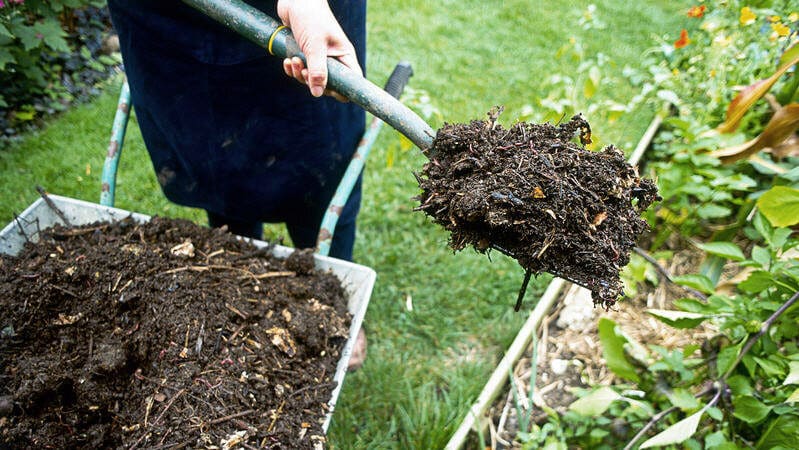
Symptoms of deficiency
A lack of nitrogen is easily recognized by the slow growth of shoots - the bushes become lethargic and stop developing. The leaves turn from dark green to light green or light green, curl, and a reddish tint appears between the veins. The roots of the bush become gray.
Phosphorus deficiency manifests itself in the form of a dark green color of leaf blades and a waxy coating. Over time they turn dark purple. The roots acquire a dark brown color, the berries become deformed, lose their elasticity and rich color.
Potassium deficiency inhibits the growth of shoots and fruits and provokes the death of adult branches. The leaves become infected with necrosis, which manifests itself as spotting, dry out and die.
Attention! In addition to the listed microelements, the development of the bush and fruiting are negatively affected by: magnesium deficiency - old leaves curl, the edges become red; lack of zinc - shoots become covered with a waxy coating; iron deficiency - the berries fall off, the leaves become covered with a brown coating.
When to feed raspberries in July
Fertilize the plant in early July. Feeding is applied in the morning, choosing a dry, warm and windless day. If you fertilize during the day, the roots, shoots and leaves will receive chemical burns, which will negatively affect the yield. It is not recommended to feed berry bushes in rainy and cool weather, which is favorable for the development of bacteria and fungi.
Attention! The frequency and abundance of fertilizers depend on the age of the plant, variety, and climatic conditions of the region. Particular attention is paid to mineral supplements. For example, nitrogen-containing fertilizers are applied once a year, and potassium and phosphorus fertilizers - once every 2 years.
What to feed
Organic and folk remedies are good because they use available ingredients for their preparation - manure, leaves, chicken droppings, potato tops, garlic, etc.. Mineral and complex fertilizers, in turn, perform several functions at once: protect against diseases, accelerate fruiting, and restore metabolism. How and with what to fertilize raspberries so that the berries are large, we will consider further.
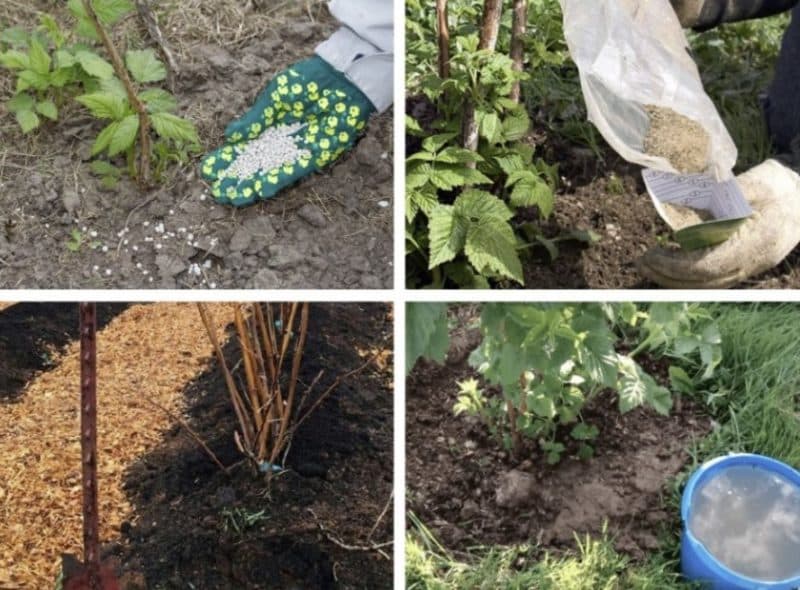
Mineral fertilizers
Nitrogen fertilizing is applied at the end of spring or in July - per 1 square meter. m take 10 g of urea and 10 g of ammonium nitrate. Fertilizers are applied in dry or liquid form, having previously prepared a solution. Summer residents choose potassium salt or wood ash as potassium supplements. The latter can always be bought at a gardening store. Ash good because it does not contain chlorine - it inhibits the development of raspberries. For 1 sq. m add 150 g of ash. Fertilize once a year.
Raspberry yields are increased using double superphosphate. To enhance its properties, gardeners prepare the following mixture: 50 g of double superphosphate, 30 g of potassium salt, 20 g of ammonium nitrate are diluted in a bucket of water. They are brought into the raspberry garden early in the morning and then watered abundantly.
Organic compounds
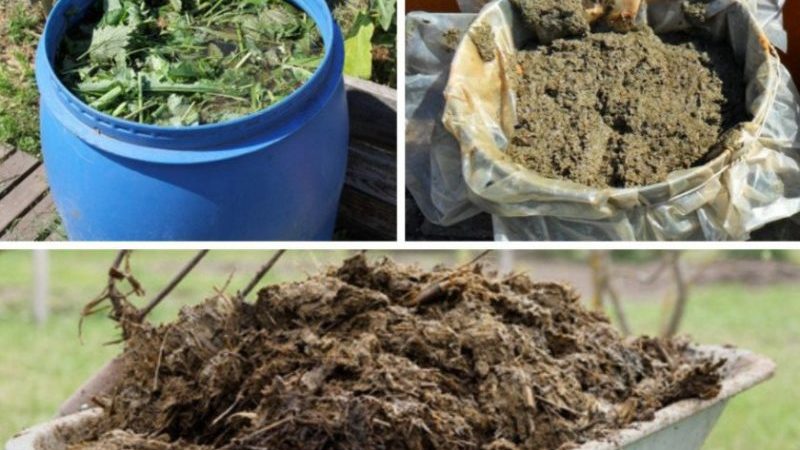
Summer residents advise stocking up on bone meal, which acts not only as a top dressing, but also as a mulch. It is rich in calcium and phosphorus and is used for fertilizer at any time of the year. Add 2 tbsp to the tree trunk circle. bone meal. It protects plants from insect pests and prevents the growth of weeds. Fertilizer is easily absorbed by raspberries.
Gardeners also add rotted manure or peat to the raspberries - 6 kg per 1 sq. m. m. Such fertilizer is required only if the plant lacks nitrogen.Some summer residents use a solution of chicken manure - this is a more delicate feeding for young raspberry bushes.
Attention! At the time of filling the berries, complex fertilizers are applied under the bush: “Aquarin”, “OMU” for fruit and berry crops, “Gumi-Omi”. They are water-soluble, balanced in composition, and safe for the environment.
Folk remedies
Ash, potato waste, soap, and onions are used as folk fertilizers. Such products are always at hand, their preparation does not require much time and effort. Many of the top dressings protect against diseases and insects:
- Dry potato peelings are buried under the raspberry bushes. They decompose and release nutrients to the plant and soil throughout the year. The peelings are used to prepare a solution - pour boiling water over it and use it for irrigation.
- Yeast in dry or liquid form promotes the decomposition of organic matter, accelerates the fruiting process, and raspberries grow tasty and sweet. 1 kg of dry yeast is diluted in 10 liters of water and infused for 2 hours. 1 liter of concentrate is diluted in 5 liters of water and sprayed on raspberries.
- 200 g of dry tobacco leaves are soaked in 5 liters of water. Raspberries are sprayed 2-3 times during the summer. The treatment protects against powdery mildew, spider mites, and aphids. Liquid soap enhances the fertilizing effect.
How to fertilize so that the berries are large
To get large fruits, summer residents pay attention to complex feeding. For example, they apply “Buy fertilizer” for fruit and berry crops. It contains nitrogen, phosphorus, potassium, magnesium, zinc, iron. Available in granules. For 1 sq. m requires 20 g.
Gardeners also note the Nutrisol fertilizer for fruit and berry crops. To prepare the working solution, 10 liters of water and 15 g of substance are required.Nutrisol is applied along with watering. Complex fertilizers are sold in gardening stores. Before using them, study the preparation recommendations and precautions.
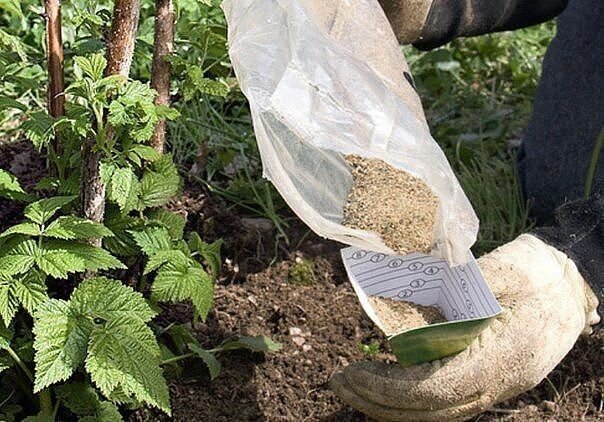
What to feed during fruiting
Gardeners use ash - a cheap and effective fertilizer. It improves the soil structure, the berries grow tasty and juicy, and have attractive commercial qualities. Dilute 1 tbsp in 10 liters of water. wood ash and leave for 10 days in a dark and dry place. Water raspberries at the rate of 2.5 liters per bush. The next feeding is carried out only in September.
Features of fertilizing remontant raspberries
In remontant varieties The berries are larger and therefore require more mineral fertilizers. Dissolve 3 tbsp in 10 liters of water. l. “Kemiry”, in the heat, water the raspberries at the root. Gardeners also fertilize the plant with ammonium sulfate. 1 bush takes about 15 g of dry matter. Increase productivity remontant raspberries using slurry - a bucket of solution is used on the bush.
Choosing feeding in the middle zone
For fertilizer in central Russia, an infusion of bird droppings is used - 1 kg of droppings is infused in 10 liters of water. The solution is left for a week in a dark place. Then dilute it in water at the rate of 1:10. If desired, add nettle or burdock to the infusion and mix. Apply 3 liters of fertilizer to each bush.
Attention! Even banana peels are used to fertilize raspberries - 10 pcs. soak in 10 liters of water and leave for a week in a cool place. The peel is rich in potassium, which is necessary for raspberries during fruiting.
In the Urals and Siberia
To grow in cold regions of the country, summer residents choose raspberry varieties with strong immunity, and to improve their quality, they fertilize them with mineral components. Use zinc sulfate, boric acid, magnesium sulfate. A drip system is used for application. It guarantees economical consumption of fertilizer, nutrients go directly to the root.
How to feed raspberries
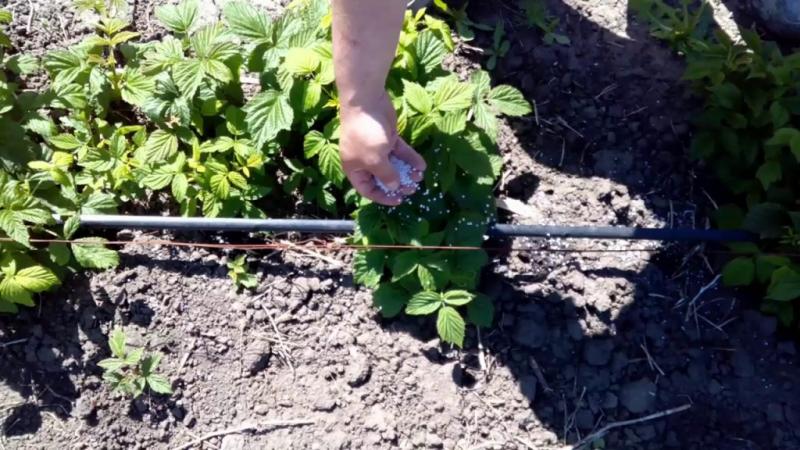
There are root and foliar (leaf) methods. The first involves applying fertilizers at the root, in the ground, the second - spraying.
The root way
Before applying fertilizers, the soil is slightly loosened and watered abundantly with warm water. A humid environment improves the absorption of organic and mineral substances. Fertilizers should not get on leaves, shoots or fruits, otherwise it will cause sunburn. Experienced summer residents recommend using gloves and safety glasses when working, especially when it comes to mineral components.
Foliar
Foliar feeding replenishes the lack of nutrients, helps microelements to be absorbed faster, and enhances fruit growth. Raspberries are treated with phosphorus and biostimulating fertilizers. Fitovert Energy is suitable for this. It is quickly absorbed, dissolves in water, and is affordable. Also, a soap or ash solution is used as foliar feeding.
Advice from experienced gardeners
To find out what to feed raspberries in July, it is recommended to regularly inspect the plant. This will help you understand what elements it is missing. Agronomists also advise:
- add ash to fertilizing if raspberries grow in acidic soil;
- fertilize plants at temperatures below +28°C;
- do not process in strong winds;
- do not allow direct sunlight to fall on the raspberries after the procedures;
- monitor the amount of fertilizer applied;
- observe intervals between procedures;
- check the expiration date of purchased products.
Conclusion
Gardeners recommend inspecting raspberries for external signs of micronutrient deficiency. This will help you understand what fertilizers to use. If nitrogen deficiency is observed, urea is added; if there is a lack of potassium - potassium salt. To strengthen the immune system and saturate the soil with nutrients, use an infusion of chicken droppings or manure. Folk remedies are also popular: infusions of ash, banana peels, and potato peelings. Before fertilizing, water the raspberries and lightly loosen the soil.